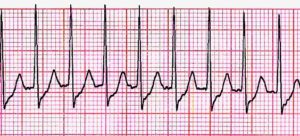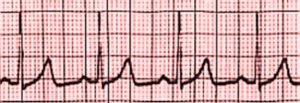Narrow Complex Regular Tachycardia
Usu
100 = tachycardia Cause be dehydration, fever, anxious reaction to drugs
>150 Could it be cardiac in origin?
Width of QRS should be less than .12

3 Situations
- StableCould be symptomatic (dizziness, palitations) but hemodynamically stable = BP>90, mentating good color MEDICATION
- Unstable Signs of shock, altered mental status, color/cyanosis SYNCHRONISED CARDIOVESRION
- PEA EPINEPHRINE
If narrow complex REGULAR consider
Assessment Stable with a Pulse/BP
- Conciousness OK
- Breathing OK oxygen
- Pulse Rapid Thready O2 , Monitor,IV
- BP OK >90
-

Supraventricular Tachycardia DX Narrow Complex Regular Stable Tachycardia
Rx MEDICATION
1- Adenosine 6mg rapid IV push
follow with 20ccs saline half life very short few seconds)
After 2 minutes 2nd dose 12mg iv push follow with saline
2- Also try vagal manouver, Valsalva
3 If adenosine does not work use B blocker calcium channel blocker
Eg Verapamil 5mg over 5 minutes
2nd Scenario
- Conciousness Not OK Unstable – Call CODE
- Breathing Not OK O2 bagging
- Pulse Not OK Rapid Thready Monitor,IV
- BP <90

DX UNSTABLE Narrow Complex Tachy Cardia
RX Synchronised Cardioversion
press HOLD DOWN SYNCH BUTTON Until it has sensed the Rhythm
50J
3rd Scenario
- Conciousness Not OK Call Code
- Breathing Not OK )2 and Airway
- Pulse ABSENT Monitor,IV
- BP absent

DX Unstable No Pulse = PEA
RX Epinephrine Vasopressin
Epi 1mg (1/10,000)/3-5min
PEA EMD (need pressure 40-60 systolic to feel an pulse)
Rhythms that cannot be PEA Vfib V tach and asystole
Epi 1mg every 3-5mins
Chest Compressions
Vascular Access (Interosseous infusion)
Consider Advanced Airway
ET CO2 monitoring
OTHER DRUGS
1 dose of Vasopressin 40 U iv/io to replace 1st or 2nd dose of epi
Asystole or slow PEA rate atropine 1mg iv every 3-5mins (up to 3 doses)
FOCUS ON WHAT IS THE CAUSE
2 leading causes
H and T Hypovolemia and hypoxia
Narrow Complex Tachycardia = volume depletion
Wide Complex slow – = dying heart
H and T’s
Hypoxia
Hypovolemia
Hydrogen (acidosis)
Hypo hyperkalemia)
Hypothermia
Toxins
Tamponade
Tension Pneumothorax
Thrombosis(coronary and PE)
Trauma